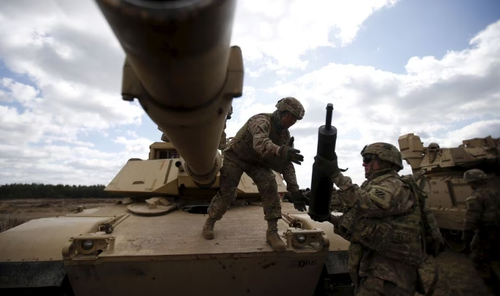 Members of the US 2nd Battalion, 7th Infantry Regiment, 1st Brigade Combat Team, 3rd Infantry Division get ammunition to the Abrams tank during an exercise at Mielno range near Drawsko-Pomorskie, April 16, 2015. (REUTERS) Members of the US 2nd Battalion, 7th Infantry Regiment, 1st Brigade Combat Team, 3rd Infantry Division get ammunition to the Abrams tank during an exercise at Mielno range near Drawsko-Pomorskie, April 16, 2015. (REUTERS) |
The rounds, which could help destroy tanks, are part of a new military aid package for Ukraine set to be unveiled in the next week. The munitions can be fired from US Abrams tanks expected be delivered to Ukraine in the coming weeks.
One of the officials said that the coming aid package will be worth between 240 million USD and 375 million USD depending on what is included. The value and contents of the package were still being finalized, the officials said.
Although Britain sent depleted uranium munitions to Ukraine earlier this year, this would be the first US shipment of the ammunition. It follows an earlier decision by the Biden administration to provide cluster munitions to Ukraine, despite concerns over the dangers such weapons pose to civilians.
A by-product of uranium enrichment, depleted uranium is used for ammunition because its extreme density gives rounds the ability to easily penetrate armor plating and self-ignite in a searing cloud of dust and metal.
The US used depleted uranium munitions in massive quantities in the 1990 and 2003 Gulf Wars and the NATO bombing of former Yugoslavia in 1999.
The use of depleted uranium munitions has been fiercely debated, with opponents like the International Coalition to Ban Uranium Weapons saying there are dangerous health risks from ingesting or inhaling depleted uranium dust, including cancers and birth defects.
The UN nuclear watchdog, the International Atomic Energy Agency, says that studies in former Yugoslavia, Kuwait, Iraq and Lebanon "indicated that the existence of depleted uranium residues dispersed in the environment does not pose a radiological hazard to the population of the affected regions."